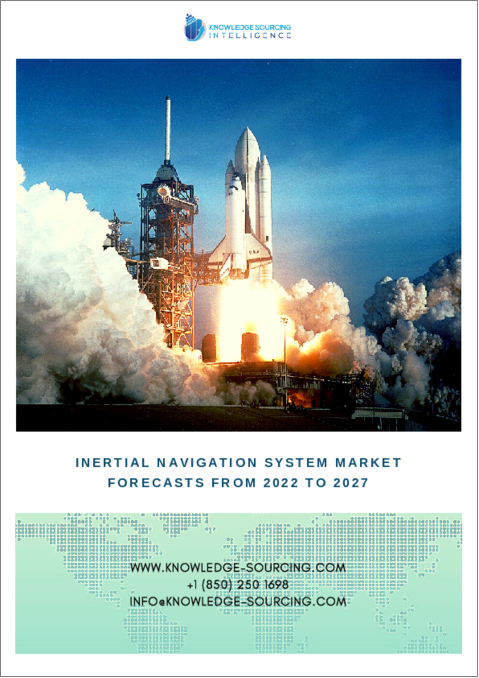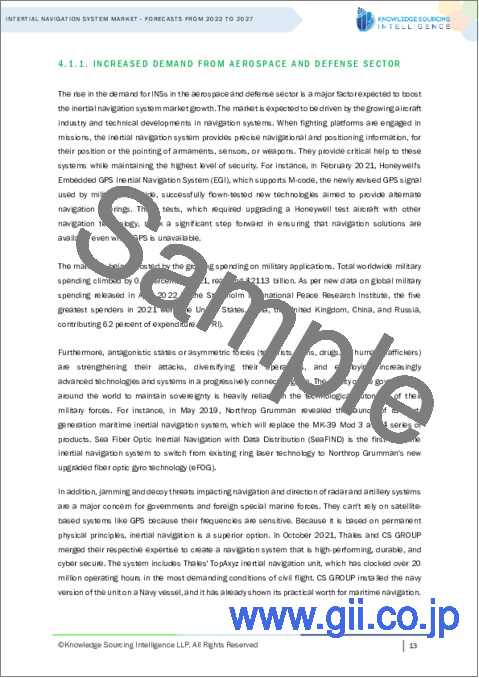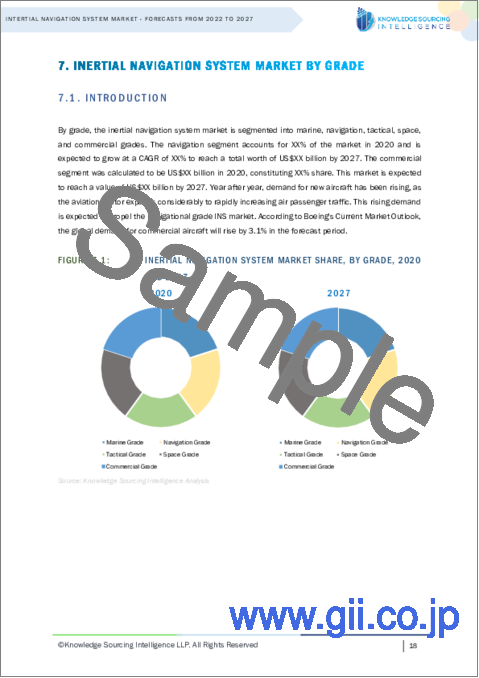|
|
市場調査レポート
商品コード
1087111
慣性航法装置:市場予測(2022年~2027年)Inertial Navigation System Market - Forecasts from 2022 to 2027 |
||||||
|
● お客様のご希望に応じて、既存データの加工や未掲載情報(例:国別セグメント)の追加などの対応が可能です。 詳細はお問い合わせください。 |
|||||||
| 慣性航法装置:市場予測(2022年~2027年) |
|
出版日: 2022年05月19日
発行: Knowledge Sourcing Intelligence
ページ情報: 英文 145 Pages
納期: 即日から翌営業日
|
- 全表示
- 概要
- 目次
世界の慣性航法装置の市場規模は、2020年に79億6,200万米ドルとなり、予測期間中に5.35%のCAGRで拡大し、2027年に114億6,400万米ドルになると予測されています。同市場を牽引する要因には、無人潜水機(UUV)の需要の増加などが挙げられます。
当レポートでは、慣性航法装置の世界市場を調査し、市場規模や予測、市場の促進要因および課題、市場動向、セグメント別の市場分析、競合情勢、主要企業のプロファイルなどの体系的な情報を提供しています。
目次
第1章 イントロダクション
- 市場概要
- COVID-19のシナリオ
- 市場の定義
- 市場セグメンテーション
第2章 調査手法
- 調査データ
- 仮定
第3章 エグゼクティブサマリー
- 調査のハイライト
第4章 市場力学
- 市場促進要因
- 市場抑制要因
- ポーターのファイブフォース分析
- 供給企業の交渉力
- 買い手の交渉力
- 新規参入者の脅威
- 代替品の脅威
- 競争企業間の敵対関係
- 業界のバリューチェーン分析
第5章 慣性航法装置の市場分析:用途別
- イントロダクション
- 航空機
- ミサイル
- 宇宙ロケット
- 海洋
- 軍用装甲車両
- 無人航空機
- 無人地上車両
- 無人航空機
第6章 慣性航法装置の市場分析:コンポーネント別
- イントロダクション
- 加速度計
- ジャイロスコープ
- アルゴリズムとプロセッサ
- ワイヤレスシステム
第7章 慣性航法装置の市場分析:グレード別
- イントロダクション
- 海洋グレード
- ナビゲーショングレード
- 戦術グレード
- 宇宙グレード
- 商用グレード
第8章 慣性航法装置の市場分析:技術別
- イントロダクション
- 機械式ジャイロ
- リングレーザージャイロ
- 光ファイバージャイロ
- MEMS
- その他
第9章 慣性航法装置の市場分析:地域別
- イントロダクション
- 北米
- 米国
- カナダ
- メキシコ
- 南米
- ブラジル
- アルゼンチン
- その他
- 欧州
- 英国
- ドイツ
- イタリア
- スペイン
- その他
- 中東とアフリカ
- イスラエル
- サウジアラビア
- その他
- アジア太平洋地域
- 中国
- 日本
- インド
- オーストラリア
- 韓国
- 台湾
- タイ
- インドネシア
- その他
第10章 競合情勢と分析
- 主要企業と戦略分析
- 新興企業と市場の有利性
- 合併、買収、合意、およびコラボレーション
- ベンダー競争力マトリックス
第11章 企業プロファイル
- Honeywell International Inc.
- Northrop Grumman Corporation
- Safran Electronics & Defence
- Thales Group
- The Raytheon Company
- Rockwell Collins, Inc.
- Teledyne Technologies, Inc.
- Vectornav Technologies, LLC
- Lord Microstrain
- Tersus GNSS Inc.
The inertial navigation system market is projected to witness a compounded annual growth rate of 5.35% to grow to US$11.464 billion by 2027, from US$7.962 billion in 2020. A navigation method in which gyroscopes and accelerometers produce readings and are used to monitor an object's position and direction relative to a predefined starting point, orientation, and speed is specified as an inertial navigation system (INS). The INS finds a wide range of applications in the manufacture of guided military weapons as well as commercially made games, computers, cameras, and medical devices.
The need for unmanned underwater vehicles (UUVs) is increasing, which is propelling the industry forward. UUVs are widely utilized in oil and gas exploration, scientific investigation, and military armament with high precision requirements. They are employed for deactivating underwater mines, counterattacking, port security, and hull inspection in the defense industry. For instance, in June 2021, in collaboration with FUSCOL@B, the French marines' ALFUSCO innovation laboratory, and Safran Electronics & Defense developed the GeonyxTM M hybrid navigation system to satisfy the special needs of marine commandos stationed both at sea and on land. GeonyxTM M is aimed for naval speed boat platforms like ECUME or landing boats, as well as land-based systems, particularly amphibious vehicles, where it can be used in navigation and pointing.
Additionally, as global oil consumption rises, UUVs are rapidly being employed for oil rig building, pipeline examinations, and regular maintenance, driving the market's growth. Another element contributing to the market's expansion is the expanding aerospace industry. Advances in space research and an increase in satellite launches have increased the use of these navigation systems, which are required to correctly detect an object's velocity and altitude. For instance, in March 2021, Israel opened a non-GPS advanced navigation facility. The new facility specializes in developing and manufacturing battlefield navigation systems, with intentions to use a co-developed, non-GPS accurate navigating technology. Israel's Ministry of Defense (IMOD) and Israel Aerospace Industries have established a Navigation Technology Center committed to designing and manufacturing non-GPS navigation systems (IAI). IAI will use the new center to research and manufacture extremely accurate inertial sensors for use in next-generation navigation systems, boosting their effectiveness and performance substantially.
Furthermore, technical breakthroughs such as the advent of light-powered and small-size navigation systems that use ring laser gyro (RLG) and fiber optic gyro (FOG) are boosting the market's possibilities.
INCREASING DEMAND FROM THE AEROSPACE AND DEFENSE SECTOR
The rise in the demand for INSs in the aerospace and defense sector is a major factor expected to boost the inertial navigation system market growth. The market is expected to be driven by the growing aircraft industry and technical developments in navigation systems. When fighting platforms are engaged in missions, the inertial navigation system provides precise navigational and positioning information, whether for their position or the pointing of armaments, sensors, or weapons. They provide critical help to these systems while maintaining the highest level of security. For instance, in February 2021, Honeywell's Embedded GPS Inertial Navigation System (EGI), which supports M-code, the newly revised GPS signal used by military worldwide, successfully flown-tested new technologies aimed to provide alternate navigation offerings. These tests, which required upgrading a Honeywell test aircraft with other navigation technology, mark a significant step forward in ensuring that navigation solutions are available even when GPS is unavailable.
The market is being boosted by the growing spending on military applications. Total worldwide military spending climbed by 0.7 percent in 2021, reaching $2113 billion. As per new data on global military spending released in April 2022 by the Stockholm International Peace Research Institute, the five greatest spenders in 2021 were the United States, India, the United Kingdom, China, and Russia, contributing 62 percent of expenditure (SIPRI).
Furthermore, antagonistic states or asymmetric forces (terrorists, guns, drugs, or human traffickers) are strengthening their attacks, diversifying their operations, and employing increasingly advanced technologies and systems in a progressively connected globe. The government's ability around the world to maintain sovereignty is heavily reliant on the technological autonomy of its military forces. For instance, in May 2019, Northrop Grumman revealed the launch of its next-generation maritime inertial navigation system, which will replace the MK-39 Mod 3 and 4 series of products. Sea Fiber Optic Inertial Navigation with Data Distribution (SeaFIND) is the first maritime inertial navigation system to switch from existing ring laser technology to Northrop Grumman's new upgraded fiber optic gyro technology (eFOG).
In addition, jamming and decoy threats impacting navigation and direction of radar and artillery systems are a major concern for governments and foreign special marine forces. They can't rely on satellite-based systems like GPS because their frequencies are sensitive. Because it is based on permanent physical principles, inertial navigation is a superior option. In October 2021, for example, Thales and CS GROUP merged their respective expertise to create a navigation system that is high-performing, durable, and cyber secure. The system includes Thales' TopAxyz inertial navigation unit, which has clocked over 20 million operating hours in the most demanding conditions of civil flight. CS GROUP installed the navy version of the unit on a Navy vessel, and it has already shown its practical worth for maritime navigation.
RISING USE OF UUV
The growing demand for unmanned marine vehicles (UUV) is propelling the market forward. UUVs are widely utilized in oil and gas exploration, scientific research, and military armament with high precision requirements. They are employed for deactivating underwater mines, counterattacking, port security, and hull inspection in the defense industry. Underwater drones aid in oceanographic studies for the charting of the ocean floor in scientific study. Furthermore, as the world's oil consumption rises, UUVs are increasingly being employed for oil rig building, pipeline inspections, and maintenance tasks, boosting the product's demand. With the increasing use of artificial intelligence (AI) and innovation, the demand for unmanned marine vehicles is anticipated to increase
SEGMENTS
- BY APPLICATION
Aircraft
Missiles
Space Launch Vehicles
Marine
Military Armored Vehicles
Unmanned Aerial Vehicles
Unmanned Ground Vehicles
Unmanned Marine Vehicles
- BY COMPONENT
Accelerometers
Gyroscopes
Algorithms and Processors
Wireless Systems
- BY GRADE
Marine Grade
Navigation Grade
Tactical Grade
Space Grade
Commercial Grade
- BY TECHNOLOGY
Mechanical Gyros
Ring Laser Gyros
Fiber Optics Gyros
MEMS
Others
- BY GEOGRAPHY
North America
- USA
- Canada
- Mexico
South America
- Brazil
- Argentina
- Others
Europe
- UK
- Germany
- Italy
- Spain
- Others
Middle East and Africa
- Israel
- Saudi Arabia
- Others
Asia Pacific
- China
- Japan
- India
- Australia
- South Korea
- Taiwan
- Thailand
- Indonesia
- Others
TABLE OF CONTENTS
1. INTRODUCTION
- 1.1. Market Overview
- 1.2. Covid-19 Scenario
- 1.3. Market Definition
- 1.4. Market Segmentation
2. RESEARCH METHODOLOGY
- 2.1. Research Data
- 2.2. Assumptions
3. EXECUTIVE SUMMARY
- 3.1. Research Highlights
4. MARKET DYNAMICS
- 4.1. Market Drivers
- 4.2. Market Restraints
- 4.3. Market Opportunities
- 4.4. Porter's Five Force Analysis
- 4.4.1. Bargaining Power of Suppliers
- 4.4.2. Bargaining Power of Buyers
- 4.4.3. Threat of New Entrants
- 4.4.4. Threat of Substitutes
- 4.4.5. Competitive Rivalry in the Industry
- 4.5. Industry Value Chain Analysis
5. INERTIAL NAVIGATION SYSTEM MARKET ANALYSIS, BY APPLICATION
- 5.1. Introduction
- 5.2. Aircraft
- 5.3. Missiles
- 5.4. Space Launch Vehicles
- 5.5. Marine
- 5.6. Military Armored Vehicles
- 5.7. Unmanned Aerial Vehicles
- 5.8. Unmanned Ground Vehicles
- 5.9. Unmanned Marine Vehicles
6. INERTIAL NAVIGATION SYSTEM MARKET ANALYSIS, BY COMPONENT
- 6.1. Introduction
- 6.2. Accelerometers
- 6.3. Gyroscopes
- 6.4. Algorithms and Processors
- 6.5. Wireless Systems
7. INERTIAL NAVIGATION SYSTEM MARKET ANALYSIS, BY GRADE
- 7.1. Introduction
- 7.2. Marine Grade
- 7.3. Navigation Grade
- 7.4. Tactical Grade
- 7.5. Space Grade
- 7.6. Commercial Grade
8. INERTIAL NAVIGATION SYSTEM MARKET ANALYSIS, BY TECHNOLOGY
- 8.1. Introduction
- 8.2. Mechanical Gyros
- 8.3. Ring Laser Gyros
- 8.4. Fiber Optics Gyros
- 8.5. MEMS
- 8.6. Others
9. INERTIAL NAVIGATION SYSTEM MARKET ANALYSIS, BY GEOGRAPHY
- 9.1. Introduction
- 9.2. North America
- 9.2.1. USA
- 9.2.2. Canada
- 9.2.3. Mexico
- 9.3. South America
- 9.3.1. Brazil
- 9.3.2. Argentina
- 9.3.3. Others
- 9.4. Europe
- 9.4.1. UK
- 9.4.2. Germany
- 9.4.3. Italy
- 9.4.4. Spain
- 9.4.5. Others
- 9.5. Middle East and Africa
- 9.5.1. Israel
- 9.5.2. Saudi Arabia
- 9.5.3. Others
- 9.6. Asia Pacific
- 9.6.1. China
- 9.6.2. Japan
- 9.6.3. India
- 9.6.4. Australia
- 9.6.5. South Korea
- 9.6.6. Taiwan
- 9.6.7. Thailand
- 9.6.8. Indonesia
- 9.6.9. Others
10. COMPETITIVE ENVIRONMENT AND ANALYSIS
- 10.1. Major Players and Strategy Analysis
- 10.2. Emerging Players and Market Lucrativeness
- 10.3. Mergers, Acquisitions, Agreements, and Collaborations
- 10.4. Vendor Competitiveness Matrix
11. COMPANY PROFILES
- 11.1. Honeywell International Inc.
- 11.2. Northrop Grumman Corporation
- 11.3. Safran Electronics & Defence
- 11.4. Thales Group
- 11.5. The Raytheon Company
- 11.6. Rockwell Collins, Inc.
- 11.7. Teledyne Technologies, Inc.
- 11.8. Vectornav Technologies, LLC
- 11.9. Lord Microstrain
- 11.10. Tersus GNSS Inc.




